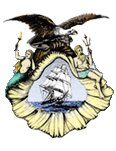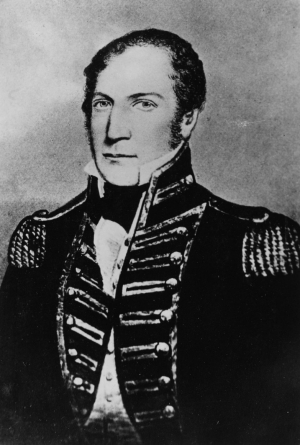Adapted from the biographical sketch for John Shaw, ZB Files, Navy Department Library, Naval History and Heritage Command.

The Navy Department Library
John Shaw
1773 - 17 September 1823

Born at Mt. Mellick, Queens County, Ireland, in 1773. Son of an officer in the British Army. Came to the United States with a younger brother in December 1790, and settled in Philadelphia, Pennsylvania. Entered the merchant marine.
Appointed Lieutenant, 3 August 1798. Master Commandant (Commander), 22 May 1804. Captain, 27 August 1807. Died, 17 September 1823.
His first naval service was as First Lieutenant of the USS Montezuma, Captain Alexander Murray, in Commodore Truxtun's squadron in the West Indies during the early part of the Naval War with France. On 20 October 1799 he was ordered to the command of the US Schooner Enterprise at Baltimore, Maryland, in which he rejoined Commodore Truxtun's squadron on the Guadaloupe Station in January 1800.
On 22 January 1800 he recaptured the schooner Victory with a valuable cargo from Norfolk bound to Antigua, which had been five days in the possession of the French, and on 24 January recaptured the brig Androscoggin of Topsham, six days in the possession of the French. He returned to the United States in February, but rejoined the squadron in March. On 17 June he captured the French privateer Cygne of 4 guns and 57 men after an engagement of 20 minutes. The Cygne had 5 killed and 14 wounded, the Enterprise 1 killed and 2 wounded. About the same time he captured the Privateer Citoyenne of 6 guns and 57 men, which surrendered only after a hard fight. On 4 July he captured the privateer Aigle of 10 guns and 78 men after a spirited engagement of 15 minutes, in which the privateer had 4 killed and 5 wounded. On 23 July he captured the privateer Flambeau of 12 guns and 90 men after an engagement of about three quarters of an hour, in which the Flambeau had 4 men killed and 20 wounded. This engagement was one of the hardest fought actions of the French War, and ended with the capture of a vessel of superior force, as the guns of the Flambeau, the same in number as those of the Enterprise, were said to be heavier, while the crew of the Enterprise numbered only 85.
While under Shaw's command the Enterprise took 3 other French armed vessels, besides making a number of recaptures. Among her prizes was a large, three-masted lugger of 12 guns, having as passengers several Army officers, including a General. At the time two American sailors were held as prisoners by the French and harshly treated on account of having killed two Frenchmen while recapturing their vessel, which later had the misfortune to be recaptured by the French. Attempts to release them by exchange had failed, and the French General and another officer were held in confinement as hostages, the General being finally allowed to go to Guadalupe on parole, where he succeeded in obtaining the release of the Americans.
In October 1800, Shaw's health broke down, and soon afterwards he was relieved of his command by Lieutenant Sterrett, and returned home in the USS Patapsco. His cruise in the Enterprise helped to make the little schooner one of the famous vessels of the Navy. After his arrival in Philadelphia he wrote, 12 December 1800, "I have in my last cruise taken thirteen sail of vessels, made 300 French prisoners, killed and wounded sixty-one men, taken forty-two pieces of artillery and 180 stand of musketry, which is already more than I could have contemplated.
He was retained in the Navy under the Peace Establishment Act of 3 March 1801, and on 4 May 1801 was ordered to the command of the USS George Washington, in which he carried tribute from the United States to Algiers, bringing back many Americans who had been taken prisoners by the Dey. On 9 July 1802 he was granted permission to make a European voyage. This permission was revoked on 21 August on account of the situation of affairs with the Barbary Powers, but was renewed on 31 August. On 30 December 1802 he was granted a furlough of 12 months to make an East India voyage.
On 25 September 1804 he was ordered to Baltimore to superintend the building of a brig and a gunboat there, and on 9 March 1805 was ordered to New York to take command of the USS John Adams, sailing on 14 May for the Mediterranean, where he joined the squadron of Commodore Rodgers, returning in November.
On 20 January 1806 he was ordered to the command of the vessels on the New Orleans Station, where he cooperated with the Army in foiling the conspiracy of Aaron Burr. He returned to Washington on the bomb ketch Vesuvius in July 1807.
On 1 March 1808 he was ordered to duty at Norfolk, Virginia, assuming command of the vessels on the station the next year. He remained on this duty until 7 July 1810, when he was again ordered to New Orleans as Commanding Officer, from which duty he was detached 18 October 1813, and ordered to report at Washington as soon as convenient. On 19 October 1814 he was ordered to the command of the USS United States at New London, Connecticut, and the naval forces there. In August 1815 he sailed from Boston in command of the United States to join the squadron of Commodore Bainbridge in the Mediterranean, assuming command when Bainbridge returned to the United States in October. He returned in the Constellation in December 1817, and in April 1818 assumed command of the Naval Station at Norfolk, in which position he remained until July 1819, when he was granted leave of absence on account of his health.
On 2 October 1819 he was ordered to the command of the USS Independence at Boston and Commander afloat on the Boston Station, which position he held until January 1822. He was again on duty at Boston during the latter part of 1822 and the early part of 1823. On 26 May 1823 he requested a change of duty to a warmer climate on account of his health. On 13 July 1823 he arrived in Philadelphia on a visit, and on 23 August was informed that he might have the command of the Charleston, South Carolina Naval Station if he desired it. He accepted the offer on 26 August, but died at Philadelphia of a fever on 17 September.
The first Shaw (DD-68) was laid down on 7 February 1916 by the Mare Island Navy Yard; launched on 9 December 1916; sponsored by Mrs. Virginia Kemper Lynch Millard; and commissioned on 9 April 1917, Lt. Comdr. Milton S. Davis in command.
The second Shaw (DD-373) was laid down on 1 October 1934 at the United States Navy Yard, Philadelphia, Pennsylvania; launched on 28 October 1935; sponsored by Miss. Dorthy L. Tinker; and commissioned on 18 September 1936, Lt. Comdr. E.A. Mitchell in command.
Dates of Service
| 1798 | 3 August | Appointed Lieutenant and ordered to USS Montezuma. |
| 20 August | Accepted appointment. Served on Montezuma as 1st Lieutenant. Commission enclosed to Captain Murray 7 September 1798. Captain Murray informed in letter of 18 August 1798 that he is appointed to command Montezuma and John Shaw of Baltimore is appointed to her as Lieutenant. | |
| 1799 | 3 August | Addressed on Montezuma at Fort Mifflin, and informed that he is probably to command one of the schooners being built in Baltimore in September. |
| 18 September | Addressed at on Montezuma at Baltimore. | |
| 30 September | Ordered to Baltimore to command the schooner Experiment, now ready. Addressed at Baltimore. Experiment given to Lieutenant Maley 3 October. | |
| 20 October | Ordered to the Enterprise. | |
| 27 November | Addressed on Enterprise. Sailing orders to join squadron on Guadaloupe Station. | |
| 1800 | 3 March | Addressed on Enterprise. Vessel to be prepared for sea with all possible expedition. |
| 12 March | Ordered to Kingston, Jamaica to join Commodore Truxtun's squadron. | |
| 12 December | Addressed at Philadelphia. Letter of 4 December requesting to be relieved from command of Enterprsie on account of health acknowledged. Relieved. | |
| 1801 | 4 May | Retained under Peace Establishment Act and ordered to take charge of George Washington and prepare her with all possible expedition to take articles due to Dey of Algiers, |
| June/July | Preparing George Washington for cruise. | |
| 1802 | 13 April | Ordered to pay off officers and crew of George Washington immediately. Addressed at Philadelphia. |
| 29 July | Granted permission to make an European voyage. On return to report to Department. Addressed at Philadelphia. | |
| 21 August | Permission to make an European voyage revoked, as state of affairs with Barbary States made it possible that his services would be required immediately. Ordered to Washington to take passage in the New York for the Mediterranean, where he would be assigned duty by the Commodore in command. | |
| 31 August | Order of 21 August revoked, and furloughed granted as of 9 July. | |
| 10 December | Permission to be furloughed for an East India voyage for not longer than 12 months granted. To report immediately on return. | |
| 1804 | 11 April | Ordered to Washington if letter received before the sailing of all the vessels of the expedition for the Mediterranean, prepared for actual service. If vessels had sailed to report to Department, but need not come to Washington. |
| 25 September | Ordered to Baltimore to superintend the building of a brig and a gunboat. Commission as Master Commandant, dated 18 May 1804, No. 3 on list, enclosed. Addressed at Philadelphia . | |
| 20 December | Commission as Master Commandant, confirmed by Senate , enclosed. Addressed at Baltimore. Confirmed 22 November 1804. Commission dated 23 November 1804, to rank from 22 May 1804. | |
| 1805 | 9 March | Informed of Secretary's intention to order him to New York to command the John Adams preparing there for the Mediterranean. Ordered to open a rendezvous for her at Baltimore. |
| 5 April | Ordered to proceed immediately to New York to take command of John Adams. Addressed at Baltimore. Ship still at New York 30 April. | |
| 25 April | Ordered to sail for Mediterranean. | |
| 14 March | Sailed for Mediterranean. | |
| November | Returned from Mediterranean. | |
| 9 November | Ordered if he arrived at Hampton before 1 December to proceed immediately to New York and await further orders. If he should not arrive until 1 December or after that date to proceed up to the Eastern Branch. | |
| 1806 | 20 January | Ordered to proceed in the next brig Franklin to New Orleans and take charge of such gunboats as were there or should arrive from the western country. All to be prepared for crews, but crews not to be entered until orders were received. |
| 8 December | Instructed to receive orders from General Wilkinson in regard to the employment of the bomb vessels and gunboats in New Orleans. | |
| 20 December | Informed that a military expedition formed on the western waters by Colonel Burr would soon proceed down the Mississippi River. Would probably be near New Orleans when letter received. Ordered to aid the Army in suppressing the expedition; to take a position to intercept and if necessary to destroy the boats. | |
| 1807 | 23 March | Ordered to dismantle the bomb vessels and gunboats on the New Orleans Station and sell the schooner Revenge and brig Franklin. |
| 31 March | Granted permission to return to Washington. | |
| 9 April | Ordered to have a vessel prepared to carry General Wilkinson and others to Richmond. Permission to take command of the vessel if he wished. | |
| 7 July | Leave to come to Washington revoked. Returned to Vesuvius in July 1807. | |
| 16 October | Promoted to Captain. Commission dated and to rank 27 August 1807. Confirmed by Senate 15 January 1808. Commission dated 16 January 1808 to rank from 27 August 1807. Delivered to him in person at the office, 14 April 1808. | |
| 7 December | Appointed a member of the Court Martial on James Barron and others at Norfolk, to be held 4 January 1808. | |
| 1808 | 1 March | Impression of medal awarded to Commodore Preble 3 March 1805 for services in Tripoli sent him. Ordered to Norfolk to report to Commodore Decatur, commanding the Naval Force there for duty. |
| 1809 | 23 March | Addressed as Commanding Officer at Norfolk. |
| 1810 | 27 February | Ordered to return to Norfolk and resume the duties of the station. Addressed as present. |
| 25 June | Granted six weeks' leave. | |
| 7 July | Ordered to New Orleans as Commanding Officer. Informed that it was a proof of the Department's confidence, as he had given satisfaction when there before, and was very acceptable to the inhabitants. | |
| 28 July | His request to go to New Orleans by way of Ohio approved. | |
| 1811 | 25 February | Thanks of Department sent to the officers and men who volunteered to suppress insurrection of the blacks. (Letter of 18 February acknowledged.) |
| 1813 | 18 October | Ordered to resign the command of the New Orleans Station to Master Commandant Patterson and report to Washington as soon as convenient. |
| 1814 | 20 May | Addressed as present. |
| 28 June | Request of 27 June to proceed to Philadelphia granted. Addressed at Baltimore. | |
| 30 July | Letter of 20 July acknowledged. Cannot have orders to active duty until accounts are settled. Addressed at Chester, Pennsylvania. | |
| 19 Ocotber | Ordered to New London, Connecticut to take command of the United States, and to employ that ship, the Macedonian and the 2 gunboats on the station for its protection. | |
| 20 November | Addressed as commanding the naval forces at New London. | |
| 1815 | 18 April | Same. |
| 22 May | Addressed on United States at Boston. | |
| 14 August | Addressed on United States at Boston. Ordered to take under his charge the store vessels Alert and Hornet and proceed with them to the Mediterranean as soon as ready to join the squadron of Commodore Bainbridge. | |
| 1817 | 31 December | Addressed on Constellation at Norfolk. |
| 1818 | 14 March | Addressed at present. |
| 7 April | Same. | |
| 9 April | Ordered to Norfolk to take command of Constellation. Addressed as present. | |
| 7 November | Ordered from Washington to St. Mary's, Georgia, and await further orders. | |
| 1819 | 29 January | Addressed at St. Mary's. |
| 27 February | Commodore Sinclair in command at Norfolk until his return. | |
| 20 July | Granted leave of absence from Norfolk until health restored. | |
| 2 October | Ordered to command the Independence at Boston and commander afloat on Boston Station. Addressed at Norfolk. | |
| 1822 | 20 March | Tried by Court Martial and suspended for 6 months for unofficer like conduct. |
| 22 October | Wrote from Boston reporting expiration of suspension and reporting for duty. | |
| 25 November | Granted permission to remain on the Boston Station until his services were required. | |
| 30 December | Requested permission to go to Washington to settle his accounts as soon as his health permitted. | |
| 1823 | 4 January | Permission granted. |
| 26 May | Wrote from Boston stating he had been attacked with chronic rheumatism the July before, and requesting duty away from Boston on account of the climate. | |
| 14 July | Wrote from Philadelphia, reporting his arrival there the day before. Requested command of the Station there. | |
| 23 August | Request refused on account of his health. Informed he might have command of the Charleston, South Carolina station. | |
| 26 August | Accepted offer. | |
| 30 August | Informed that as soon as his health would permit he should have orders to Charleston, South Carolina. | |
| 17 September | Died at Philadelphia of a fever. |
[END]



